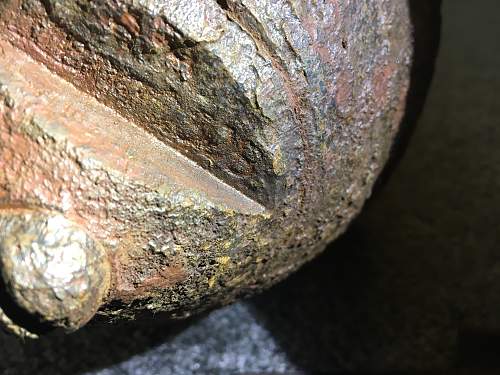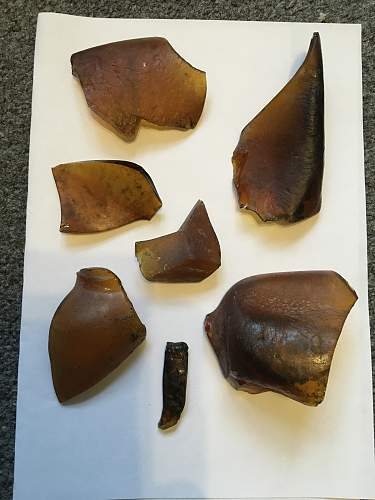SC 50 'Brand' Aircraft Bomb
Article about: Hello folks. A recent pickup from eBay, of all places! A relic SC 50 aircraft bomb, minus tail fin. First thing's first, I will assure everyone here that this bomb is fully inert. I have rem
-
 SC 50 'Brand' Aircraft Bomb
SC 50 'Brand' Aircraft Bomb
Hello folks.
A recent pickup from eBay, of all places! A relic SC 50 aircraft bomb, minus tail fin.
First thing's first, I will assure everyone here that this bomb is fully inert. I have removed the filler cap and the fuse, and have found no remaining explosive content.
The SC 50 (Sprengbombe Cylindrisch - Explosive Bomb, Cylindrical 50kg) was the smallest size of bomb employed by the Luftwaffe during the Second World War. It was dropped in significant numbers during the Blitz, and had multiple variants outfitted for usage on different targets. This particular variant is the SC 50 B, the 'B' indicating an incendiary variant. This variation was filled with multiple glass bottles, which contained white phosphorus. Upon impact, the bottles shattered and released their contents. It performed a similar function to the more common B1E 1kg incendiary bomb, only with a much higher explosive yield. Production of this variant was discontinued in 1936, likely as a result of a preference for the B1E, which could be produced, carried and dropped in much greater numbers, and were much more effective at starting large-scale fires.

This is, obviously, a relic example. It has seen better days, but remains solid. It shows signs of a hard impact with the ground on one side. There is one marking barely visible on the nose plug. Any painted markings on the casing have long been lost to corrosion.




It is fitted with an ELAZ 25 D electrical impact fuse, complete with transport cap and locking ring. It can be removed, and the chamber behind it is empty.


Inside the bomb, amongst the burnt residue and dirt, I discovered several pieces of broken glass. I thought at first that these were rubbish, but after some research I've come to the conclusion that they are the remains of the bottles which contained the white phosphorus. I reiterate that the bomb is completely empty, and weighs only 15 kilograms. At some point I will be cleaning out the inside of the casing, and treating the exterior to prevent further rusting.

Some technical information on these bombs, as provided by Jb4046:
50kg Brand C50B Incendiary Bomb
Overall Length: 43.5 inches (approx.)
Body Length: 30.5 inches
Body Diameter: 8 inches
Wall Thickness: 1/16 to 1/8 inches
Tall Length: 17 inches
Tail Width: 7.8 inches
Filling: White phosphorus
Total weight: 77 pounds (approx.)
Color: The bomb is painted light fawn overall with a red priming coat. The following markings were found on the specimen recovered:
-On the bomb body:
"Brand C 50 B" (black).
Red band 5/8 inch wide.
"10 PQ" (red).
Bottle 3 inches long (red).
-On the bomb nose:
Red band 3/4 inch wide
"Brand C 50 B" stamped on nose plug.
Construction: This bomb consists of a rolled sheet steel cylinder, seam welded longitudinally. The base and nose portions are welded circumferentially to the bomb body. The nose portion of this bomb is much larger than that of the Brand C50A, and the base plate filling cap is of the female type with two studs projecting rearwards.
The sheet steel tail assembly is secured over and to the base of the bomb body by means of two screws which enter the vertical arms of the L-shaped brackets, welded to the shoulder formed at the base of the bomb. Four positioning plates are also welded to this shoulder and aid in positioning the tail on the bomb.
The bomb houses a single fuze pocket, located forward on the side of the bomb body. An extension tube extends from the nose of the bomb to the forward side of the fuze pocket. A wooden plug was found in the tube of the recovered specimen of this bomb.
Operation: When the impact fuze functions, the detonation of the picric ring in the fuze pocket splits open the bomb casing, ejects some or all of the incendiary filling, and breaks the bottle containing the white phosphorus, which ignites the incendiary filling.
Suspension: This bomb is fitted for horizontal suspension only.
These are hard items to come by, and I'm glad I've found one. Even if it is in rough shape, and missing its tail fin, it is an example of a bomb which was doubtlessly dropped on Britain during the Blitz.
Regards, B.B.
-

I wonder how safe that thing is.
-


by
Chrish124

I wonder how safe that thing is.
The interior of the casing is empty, and there is nothing in the fuse chamber either. The biggest danger it poses would be dropping it on my foot! It is an unnerving thing to look at, but perfectly safe.
B.B.
-

Would love to have seen the postman's face carrying that one up the garden path!
-


by
BlackCat1982

Would love to have seen the postman's face carrying that one up the garden path!
Luckily, the seller packaged it in a discreet manner, in layers of bubble wrap and cardboard. It proved quite difficult to get it out of the packaging, but it survived its journey to me intact.
I do wonder how my local postman would react if he knew what he was delivering to me on a regular basis!
B.B.
-

Now you just need to get some fins for it!
-


by
BlackCat1982

Now you just need to get some fins for it!
It might not be possible to attach one, unfortunately, as the bomb's impact with the ground has slightly deformed the top end, and bent one of the retaining brackets. (You can see the deformation in the photograph of the filler cap). It looks as if the original fin was sheared off on impact.
For the time being, I'll keep it as it is. It's easier to store without the fins, and I don't currently have the space to display it in the open. When the time is right, and I've got a new bigger room, I'll look into finding a replacement.
B.B.
-

Looks really cool mate! The only harm it can do now is if your drop on your foot...
Please add photos once you are displaying it!
-


by
Jb4046

Looks really cool mate! The only harm it can do now is if your drop on your foot...
Please add photos once you are displaying it!
It won't be on open display for a while. Once I'm in a new room with more space, I'll be able to. But until the house move, which isn't happening now until next year, it'll have to remain stashed under the bed.
B.B.
-

I would suggest making a hole in the roof of the new house and pocking it through that?
....
Oh, perhaps not then.
 Posting Permissions
Posting Permissions
- You may not post new threads
- You may not post replies
- You may not post attachments
- You may not edit your posts
-
Forum Rules












 .
.


Bookmarks